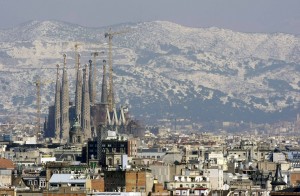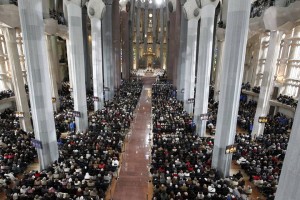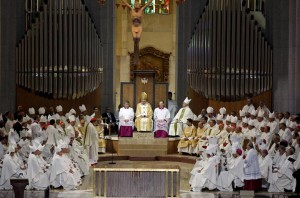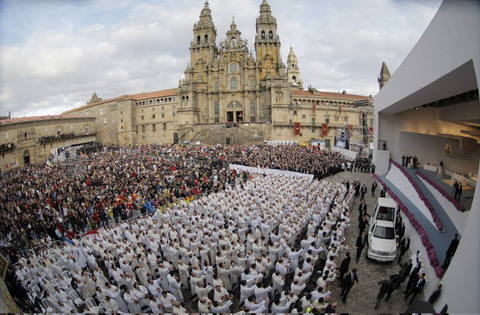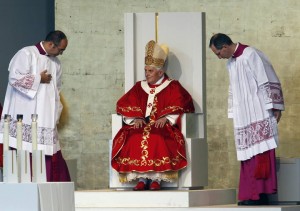The Berwickshire News, Thurs,
October 07 2010 www.berwickshirenews.co.uk.
 |
Picture:
Knight Templar, Achie Shiels from Ayton is
welcomed to Spain
by the Mayor of Teba |
Ayton’s
Knight Templar’s pilgrimage to Spain.
AN AYTON man led a special visit to Spain recently to remember a crucial
battle that took place back in 1330.
A group of Knight Templars from the Preceptory of St Bernard of Clairvaux,
fronted by Archie Shields travelled to Teba
on September 19 to take part in a day of events in memory of Sir James Douglas
and other Scots . that fell in battle well over 600 years ago.
History states that Sir lames, friend and lieutenant of Robert the Bruce,
was asked by Bruce on his death bed to take his heart on a crusade to the Holy Land
Douglas set out
bearing Bruce's heart in a silver casket. The party stopped first at Sluys in Flanders. There they received confirmation that Alfonso
XI of Castile was preparing
a campaign against the Muslims of the kingdom of Granada.
Accordingly, they sailed on to Seville,
where Sir James and his solemn relic were received by Alfonso with great honour.
 |
| Teba Castle |
Douglas and his company joined Alfonso's army, which was then setting
out for the frontier of Granada to besiege the castle·
of Teba, but unfortunately at some
point during the stage, Douglas was killed
His body and Bruce's heart were later recovered and eventually both Sir James
and Robert the Bruce's remains returned to Scotland
On arrival in Teba, Archie
and the rest of the Knight Templars were greeted with a warm reception from locals
and were welcomed at the village's town hall by the mayor, after which a
memorial took place in the council chambers.
The service was conducted by the Rt Rev Peter Miln and a passage was
read by David Bruce Lochart, whose ancestor, Sir Simon Lochart, fought at the
battle of Teba.
The service was followed by a civic reception where gifts were exchanged
and the Order presented letters of good will from Andrew Bruce, The Earl of
Elgin and David Niven, Grand Master of the Order of Scotland
A letter was also handed over on behalf of the Abbot and monks of the Cistercian
Abbey of Nunraw, East Lothian.
From the town hall, a procession took place to the Bruce/Douglas memorial
where floral tributes were laid on behalf of The Great Priory of Scotland, The
District Grand Priory of South East Scotland and The Preceptory of St Bernard
of Clairvaux in memory of those Scots that fell on the plains of Teba on the 1330.
A piper played The Flowers of the
Forest, and at the end of the ceremony a crowd of several hundred villagers
Simultaneously gave a rousing round of applause.
Then the knights returned back to the town hall where they were dismissed.
Later, a formal dinner took place near to the Castle De La Estrella (the
castle of the stars) were the large part of the action took place during the battle
of Teba.
Archie said the trip would be something he'd never forget and felt immensely
proud to have been at the helm of the Templars for the occasion.
He. commented: "Our visit fell in line with Teba's own memorial days and the response we got from the villagers
who turned out on the streets on hearing of our coming, was fantastic.
"There were 40 of us Scots went .across and then there was also the
equivalent of Spanish knights. To my knowledge it was the first time so many
Scots had made the memorial trip.
"The village itself was decked out terrifically with St Andrew's
crosses everywhere which made the occasion seem even more special.
"Some representatives from a Scottish living history group just so
happened to be over there the same time as us, so we had people dressed up as Robert
the Bruce and Sir James Douglas in our parade.
"I grew up in Lanarkshlre, not too far from the Douglas Estate. As a child I read about James Douglas and
his involvement in the Battle of Bannockburn and after I
heard the story of Teba at the age of eight, I made a promise to myself that I
would one day visit the place.
"The opportunity came to me as a member of the Preceptory and I put
it to them about doing a pilgrimage to the village.
‘They were keen and as they say the rest is history so I’ve now
fulfilled my ambition.”
 |
| Teba Procession |
Bunting of Saltire (St Andrew) Flags by the Teba community






